 |
HP OpenVMS systems documentation |
| Previous | Contents | Index |
In a multihost SCSI OpenVMS cluster system, you can increase disk storage availability by configuring the cluster for both types of multipath failover (direct SCSI to direct SCSI and direct SCSI to MSCP served SCSI), as shown in Figure 6-3.
Figure 6-3 Direct SCSI to MSCP Served Configuration With Two Interconnects
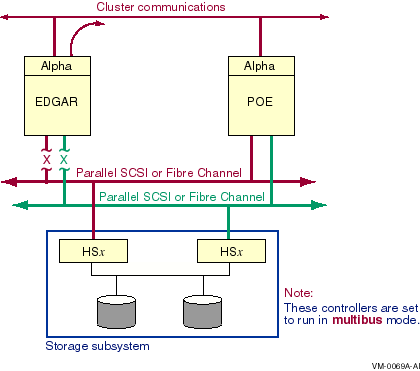
Note the following about this configuration:
This configuration provides the advantages of both direct SCSI failover
and direct to MSCP served failover.
6.2 Configuration Requirements and Restrictions
The requirements for multipath SCSI and FC configurations are presented in Table 6-1.
| Component | Description |
|---|---|
| Host adapter | For parallel SCSI, the KZPBA-CB must be used. It is the only SCSI host adapter that supports disk multipath failover on OpenVMS. For Fibre Channel, both the KGPSA-BC and the KGPSA-CA support multipath failover on OpenVMS. |
| Alpha console firmware | For systems with HSZ70 and HSZ80, the minimum revision level is 5.3 or 5.4, depending on your AlphaServer. For systems with HSG80, the minimum revision level is 5.4 |
| Controller firmware | For HSZ70, the minimum revision level is 7.3; for HSZ80, it is 8.3; for HSG80, it is 8.4. For MDR, the minimum revision level is 1170. |
| Controller module mode | Must be set to multibus mode (disks only). The selection is made at the HS x console. |
| Full connectivity |
All hosts that are connected to an HS
x in multibus mode must have a path to both HS
x controller modules. This is because hosts that are connected
exclusively to different controllers will switch the logical unit back
and forth between controllers, preventing any I/O from executing.
To prevent this from happening, always provide full connectivity from hosts to controller modules. If a host's connection to a controller fails, then take one of the following steps to avoid indefinite path switching:
|
| Allocation classes |
For parallel SCSI, a valid HSZ allocation class is required (see
Section 6.5.3). If a SCSI bus is configured with HSZ controllers only,
and all the controllers have a valid HSZ allocation class, then it is
not necessary to adhere to the older SCSI device naming rules for that
bus. That is, the adapters require neither a matching port allocation
class nor a matching node allocation class and matching OpenVMS adapter
device names.
However, if there are non-HSZ devices on the bus, or HSZ controllers without an HSZ allocation class, you must follow the standard rules for shared SCSI buses for node and port allocation class assignments and for controller device names. Booting from devices with an HSZ allocation class is supported on all AlphaServers that support the KZPBA-CB except for the AlphaServer 2 x00(A). The controller allocation class is not used for FC devices. Note: If you are using Volume Shadowing for OpenVMS, every disk must have a nonzero allocation class. All FC disks attached to HSG and HSV controllers are automatically assigned the allocation class value of 1, which satisfies the volume shadowing requirement. |
The restrictions for multipath FC and SCSI configurations are presented in Table 6-2.
| Capability | Description | ||||||||||
|---|---|---|---|---|---|---|---|---|---|---|---|
| Devices supported |
DKDRIVER disk devices attached to HSZ70, HSZ80, HSG60, HSG80, and
HSV110 controller modules are supported. MKDRIVER tapes and GKDRIVER
tape robots attached to an MDR are supported. Other device types, such
as tapes, and generic class drivers, such as GKDRIVER, are not
supported.
Note that under heavy load, a host-initiated manual or automatic switch from one controller to another may fail on an HSZ70 or HSZ80 controller. Testing has shown this to occur infrequently. This problem has been fixed for the HSZ70 with the firmware HSOF V7.7 (and later). The problem will be fixed for the HSZ80 in a future release. This problem does not occur on HSG x or HSV x controllers, nor on the MDR. |
||||||||||
| Mixed-version and mixed-architecture clusters |
All hosts that are connected to an HSZ, HSG, or HSV in multibus mode
must be running OpenVMS Version 7.2 or higher.
To use multipath failover to a served path, MPDEV_REMOTE must be enabled on all systems that have direct access to shared SCSI or Fibre Channel devices. The first release to provide this feature is OpenVMS Alpha Version 7.3-1. Therefore, all nodes on which MPDEV_REMOTE is enabled must be running OpenVMS Alpha Version 7.3-1 or later. |
||||||||||
|
SCSI to MSCP failover
MSCP to SCSI failover |
Multiple hosts must be attached to SCSI disk devices via a shared SCSI bus (either parallel SCSI or Fibre Channel). All the hosts on the shared SCSI bus must be running OpenVMS Alpha Version 7.3--1, and the MPDEV_REMOTE system parameter must be set to 1 on these hosts. | ||||||||||
| Volume Shadowing for OpenVMS |
The use of default settings for certain system parameters may lead to
the occasional removal of shadow set members that are configured for
multipath support. The shadow set members where this has been observed
are using Volume Shadowing for OpenVMS.
Therefore, when configuring multipath shadow sets using Volume Shadowing for OpenVMS, observe the following recommended setting for these system parameters:
|
The HSZ70, HSZ80, and HSGx implement two modes of failover operation when they are in a dual-redundant configuration, transparent failover mode, and multibus failover mode. HSVx supports multibus failover only.
Starting with OpenVMS Alpha Version 7.3, transparent failover mode for the HSGx is supported. |
For the system to operate correctly, the HSx failover mode
must be compatible with the configuration of the interconnect hardware
and the host operating system software, as described in the following
sections.
6.3.1 Transparent Failover Mode
In transparent failover mode, the HSx presents each logical unit on one port of the dual controller pair. Different logical units may be assigned to different ports, but an individual logical unit is accessible through one port at a time. As shown in Figure 6-4, when the HSZ detects that a controller module has failed, it moves the logical unit to the corresponding port on the surviving controller.
Figure 6-4 Storage Subsystem in Transparent Mode
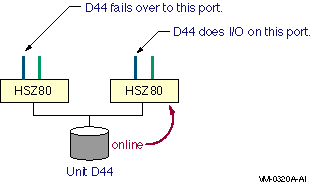
The assumption in transparent mode is that the two ports are on the same host bus, so the logical unit can move from one port to the other without requiring any changes to the host's view of the device. The system manager must ensure that the bus configuration is correct for this mode of failover. OpenVMS has supported transparent failover for HSZ controllers since Version 6.2.
To select transparent failover mode on the HSZ or HSG, enter one of the following commands at the console, depending on your configuration:
HSZ> SET FAILOVER COPY=THIS_CONTROLLER |
or
HSZ> SET FAILOVER COPY=OTHER_CONTROLLER |
An example of the output of a console SHOW command on an HSZ in transparent mode follows:
z70_A => SHOW THIS_CONTROLLER
Controller:
HSZ70 ZG64100160 Firmware XB32-0, Hardware CX25
Configured for dual-redundancy with ZG64100136
In dual-redundant configuration
Device Port SCSI address 7
Time: 02-DEC-1998 09:22:09
Host port:
SCSI target(s) (0, 2, 3, 4, 5, 6)
Preferred target(s) (3, 5)
TRANSFER_RATE_REQUESTED = 20MHZ
Host Functionality Mode = A
Allocation class 0
Command Console LUN is target 0, lun 1
Cache:
32 megabyte write cache, version 4
Cache is GOOD
Battery is GOOD
No unflushed data in cache
CACHE_FLUSH_TIMER = DEFAULT (10 seconds)
NOCACHE_UPS
|
In multibus failover mode, the HSx responds to SCSI Inquiry commands from the host on all ports of the dual controller pair. This allows the host to be aware of all the possible paths to the device. There are two advantages to having the host aware of all the paths to a device:
Note that, although the logical unit is visible on all ports, it is on line and thus capable of doing I/O on the ports of only one controller at a time. Different logical units may be on line to different controllers, but an individual logical unit is on line to only one controller at a time, as shown in Figure 6-5.
Figure 6-5 Storage Subsystem in Multibus Mode
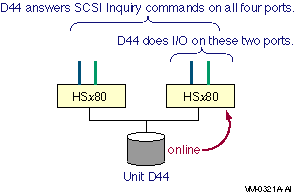
You can determine which controller a logical unit is on line to by entering the HSx console command, as follows:
z70_A => SHOW UNIT FULL
LUN Uses
--------------------------------------------------------------
D200 DISK20300
Switches:
RUN NOWRITE_PROTECT READ_CACHE
MAXIMUM_CACHED_TRANSFER_SIZE = 32
ACCESS_ID = ALL
State:
ONLINE to the other controller
PREFERRED_PATH = OTHER_CONTROLLER
Size: 2050860 blocks
|
The host executes I/O to a logical unit on one path at a time, until that path fails. If a controller has two ports, as the HSZ80 and the HSG80 controllers do, then different hosts can access the same logical unit over different ports of the controller to which the logical unit is on line.
An HSx in multibus failover mode can only be used with the multipath functionality introduced in OpenVMS Version 7.2.
To select multibus failover mode, enter one of the following commands at the HSx: console, whichever is appropriate to your configuration:
HSZ> SET MULTIBUS_FAILOVER COPY=THIS_CONTROLLER |
or
HSZ> SET MULTIBUS_FAILOVER COPY=OTHER_CONTROLLER |
An example of the output of a console SHOW command on an HSx controller in multibus mode follows:
z70_B => SHOW THIS_CONTROLLER
Controller:
HSZ70 ZG64100136 Firmware XB32-0, Hardware CX25
Configured for MULTIBUS_FAILOVER with ZG64100160
In dual-redundant configuration
Device Port SCSI address 6
Time: NOT SET
Host port:
SCSI target(s) (0, 2, 3, 4, 5, 6)
TRANSFER_RATE_REQUESTED = 20MHZ
Host Functionality Mode = A
Allocation class 0
Command Console LUN is target 0, lun 1
Cache:
32 megabyte write cache, version 4
Cache is GOOD
Battery is GOOD
No unflushed data in cache
CACHE_FLUSH_TIMER = DEFAULT (10 seconds)
NOCACHE_UPS
|
There is a difference between parallel SCSI and FC in the way that the ports on multibus controllers are addressed. In parallel SCSI (the HSZ70 and the HSZ80), all the ports are assigned the same SCSI target IDs. This is noted for the HSZ80 configuration shown in Figure 6-6.
Figure 6-6 Port Addressing for Parallel SCSI Controllers in Multibus Mode
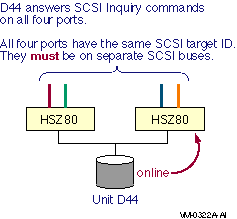
The reason all the ports have the same target ID is that the target ID is part of the OpenVMS device name (for example, the 6 in $4$DKC600), and the device name must be the same for all paths. This means that each port must be on a separate SCSI bus or there will be an address conflict.
In Fibre Channel configurations with the HSGx or the HSVx, all the ports have their own FC address and WWID, as noted in Figure 6-7. The same is true for the MDR.
Figure 6-7 Port Addressing for Fibre Channel Controllers in Multibus Mode
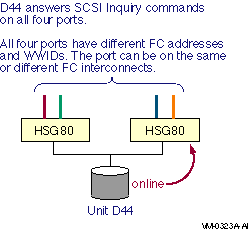
The ports on the HSGx and the HSVx have separate FC
addresses and WWIDs because these items are not used in the OpenVMS FC
device name. This means that any number of ports can be connected to
the same FC interconnect. In fact, all the ports of the HSGx
or HSVx in multibus mode should be connected, even if there is
just one interconnect, because this can improve availability and
performance.
6.4 Parallel SCSI Multipath Configurations (Disks Only)
The figures in this section show systems configured for transparent
failover and for multipath failover. The special considerations for
controller modules that have multiple ports, such as the HSZ80, are
also described.
6.4.1 Transparent Failover
Transparent failover in a parallel SCSI configuration, as shown in Figure 6-8, requires that both controller modules be on the same SCSI bus.
Figure 6-8 Parallel SCSI Configuration With Transparent Failover
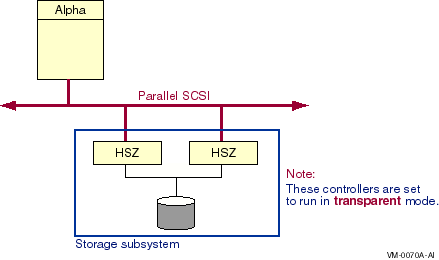
In this configuration:
A parallel SCSI configuration with multiple paths from the host to storage offers higher availability and performance than a configuration using transparent failover. Figure 6-9 shows this configuration.
Figure 6-9 Parallel SCSI Configuration With Multibus Failover and Multiple Paths
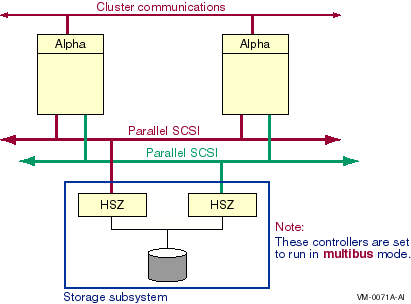
Note the following about this configuration:
Higher levels of availability and performance can be achieved with the use of multiported storage controllers, such as the HSZ80. The HSZ80 storage controller is similar to the HSZ70 except that each HSZ80 controller has two ports.
This section shows three configurations that use multiported storage controllers. The configurations are presented in order of increasing availability.
Figure 6-10 shows a single host with a single interconnect, using an HSZ80 in transparent mode.
Figure 6-10 Multiported Parallel SCSI Configuration With Single Interconnect in Transparent Mode
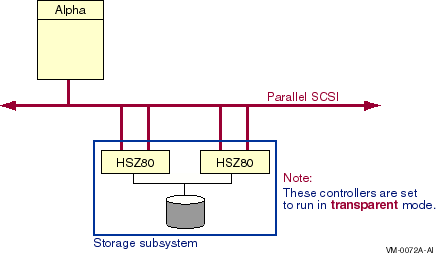
Note the following about this configuration:
Figure 6-11 shows a system configured in transparent mode using two paths from the host.
Figure 6-11 Multiported Parallel SCSI Configuration With Multiple Paths in Transparent Mode
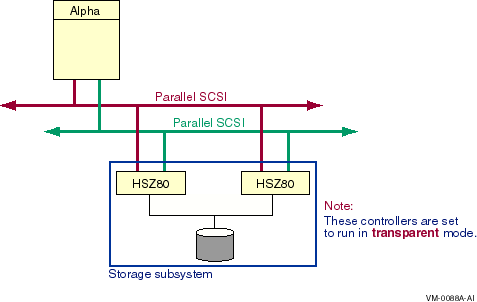
In this configuration:
Note that in this configuration, although there are two buses, there is only one path from the host to a particular logical unit. When a controller fails, the logical unit moves to the corresponding port on the other controller. Both ports are on the same host bus.
This configuration has better performance than the one in Figure 6-10 because both SCSI buses can be simultaneously active. This configuration does not have higher availability, however, because there is still only one path from the host to the logical unit.
Figure 6-12 shows a system using the multiported HSZ80 storage controller configured in multibus mode.
Figure 6-12 Multiported Parallel SCSI Configuration With Multiple Paths in Multibus Mode
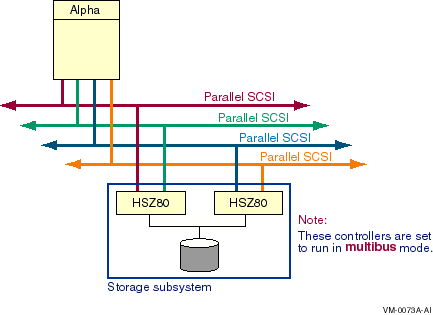
In this configuration:
SCSI device names have evolved as systems have become larger and more complex. At first, SCSI device names were entirely path dependent. The device name indicated the node, host adapter, SCSI bus ID, and logical unit number (LUN) used to access the device. Path-based names are not suitable for multiple host and multiple path environments because:
The first two of these issues were addressed by the use of the node
allocation class and the port allocation class. The third issue
requires the introduction of an HSZ controller-based allocation class.
These three allocation classes are reviewed in the following sections.
6.5.1 Review of Node Allocation Classes
A node allocation class is used in a device name in place of a node name. A node allocation class is needed to produce a unique device name when multiple nodes have a direct connection to the same SCSI device.
A node allocation class can only be used in a device name when all nodes that share access to a SCSI storage device:
Figure 6-13 shows a configuration whose devices are named using a node allocation class.
Figure 6-13 Devices Named Using a Node Allocation Class
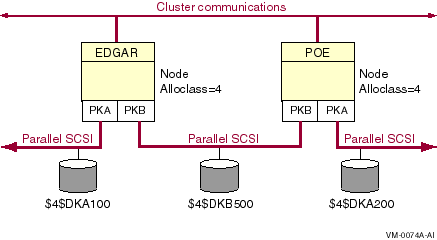
A port allocation class in a device name designates the host adapter that is used to access the device. The port allocation class replaces the node allocation class in the device name, and the adapter controller letter is set to the constant A.
The port allocation class can be used when SCSI systems need more SCSI IDs to produce unique device names, or when the controller letter of the adapters on a shared bus do not match. A port allocation class can only be used in a device name when all nodes that share access to a SCSI storage device have only one direct path to the device.
Figure 6-14 shows a configuration whose devices are named using a port allocation class.
Figure 6-14 Devices Named Using a Port Allocation Class
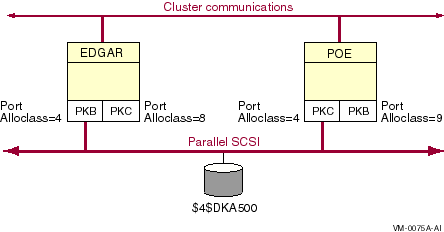
| Previous | Next | Contents | Index |